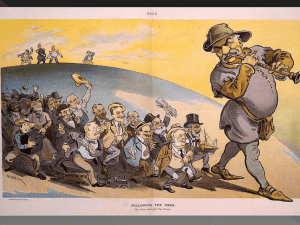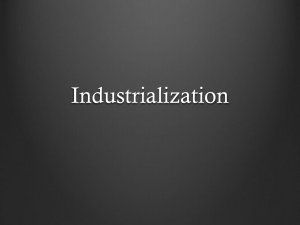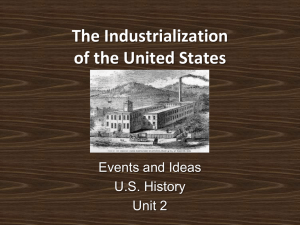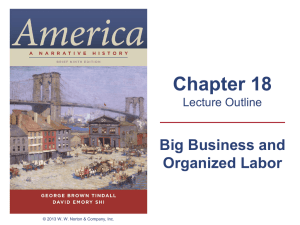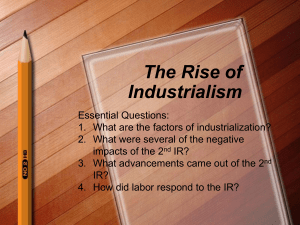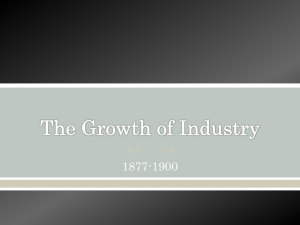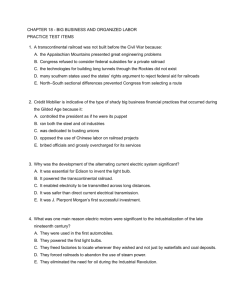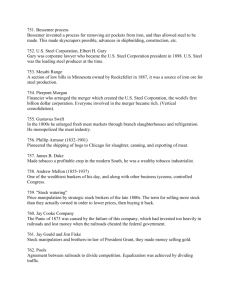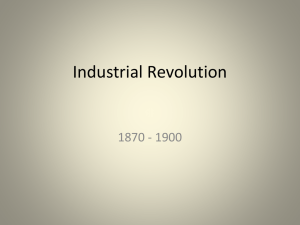Chapter 6 A New Industrial Age
advertisement
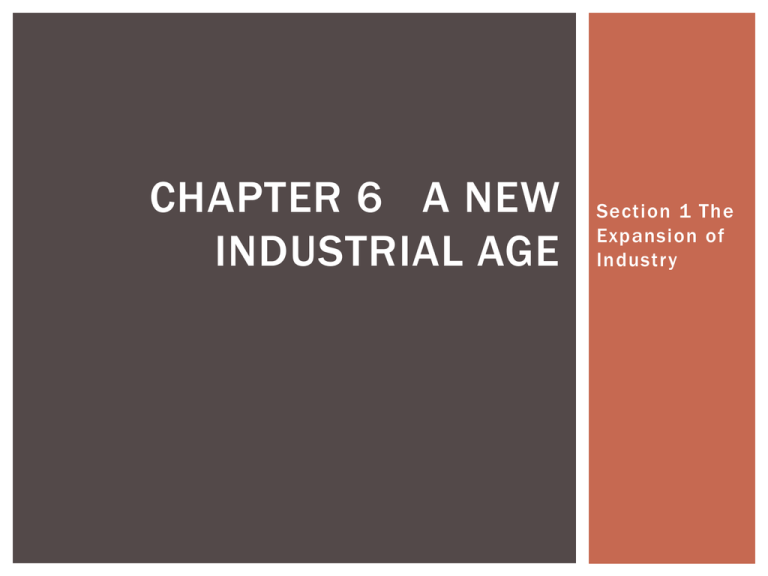
CHAPTER 6 A NEW INDUSTRIAL AGE Section 1 The Expansion of Industry NATURAL RESOURCES FUEL INDUSTRIALIZATION Several factors to industrial boom: wealth of natural resources, government support for business, and urban population growing Edwin L. Drake: used the steam engine in drilling process to increase capacity of oil output Bessemer Process: process of Injecting hot air into iron to make steel which was a stronger material NATURAL RESOURCES FUEL INDUSTRIALIZATION New uses for Steel: Brooklyn Bridge, skyscrapers, and cars Thomas Alva Edison: invented a system of producing and distributing electricity over greater areas Christopher Sholes: invented the typewriter Alexander Graham Bell: invented telephone and world wide communications network SECTION 2 THE AGE OF THE RAILROADS American History chapter 6 THE AGE OF THE RAILROADS America makes the first transcontinental railroad, it connects the east and west coast Professor C. F. Dowd: invents time zones by dividing up the earth into 24 time zones The railroads puts demands on major manufacturing for the products from them New towns and markets develop along the railroad George M. Pullman: Company that produces sleeper cars for travelers, eventually so big that he makes his own town and rules Credit Mobilier: a construction company that charged two to three times the actually cost were the owners made the excess profit. The Grange demands government control of the railroad because of abuses: government land grants and selling excess for profit, and overcharging cargos to there destinations Granger laws: set maximum freight and passenger rates along with prohibiting discrimination Munn v. Illinois: challenges granger laws, Supreme court upholds the granger laws Interstate Commerce Act 1887: Federal government supervises railroad activities and establishes a five member commission/interstate commerce commission to regulate rates Panic and Consolidation: many railroads go bankrupt, JP MORGAN and Company takes over and reorganizes the railroads. SECTION 3 BIG BUSINESS AND LABOR American History chapter 6 BIG BUSINESS AND LABOR Andrew Carnegie Steel Company Business innovations Vertical Integration: a process of buying out his suppliers needed in his business Horizontal Integration: a process of buying out all competitors and controlled the prices Social Darwinism and business Social Darwinism: believed in the process of natural selection, only the strong will survive and live on. 4000 millionares emerged after the Civil War John D. Rockefeller: Standard Oil Company Joined competing companies in trust agreements and led his control of oil industry Controlled 90% of the oil refining business Critics of these big business people called them ROBBERBARONS Eventually gave away half his fortune to charities and other foundations: started the Rockefeller foundation GOVERNMENT, THE SOUTHERN ECONOMY, AND THE UNIONS Sherman Anti-trust act: made it illegal to form a trust that interfered with free trade between States. The act was hard to enforce and courts threw out most of the cases Southern economy was bypassed by the industrial boom Long hours, poor working conditions, and low wages brings labor unions to form National Labor Union, Knights of labor, and Samuel Gompers American Federation of labor brings dif ferent skilled people to form unions Colored people were not able to join so they formed their own unions Industrial Unions: Eugene V. Debs forms American Railway Union William “Big Bill” Haywood forms Industrial Workers of the World or the Wobblies All strike in protest of better working conditions GREAT STRIKES The Great Strike of 1877: Baltimore and Ohio Railroad protest 2 nd wage cut in a month, the strike turns violent The Haymarket Af fair: Protest of police brutality turns violent after someone from the protesters tossed a bomb into the crowd. The Homestead Strike: At Carnegie steel plant in Pennsylvania about bad working conditions, the Pinkerton Detective Agency was there to protect plant and workers who were still on the job, it turns violent Pullman Company Strike: After cutting workers and wages, workers went on strike, and he hired strikebreakers. This clash between workers and strikers turned violent. Women organize under Mary Harris Jones (Mother Jones) to protect women and child labor Triangle Shirtwaist factory fire: Brings government into reform labor and conditions. Workers were locked in building with no way to escape. Many factories forced workers to sign Yellow Dog Contracts (workers could not join labor unions). Unions would continue to grow throughout the century.
